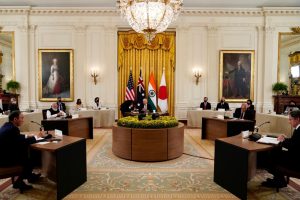At the beginning of 2021 the Quad, which involves Australia, India, Japan, and the United States, had only met a couple of times at the ministerial level. Despite years of steadily building progress, the Quad was still plagued by criticism that it lacked coherence and might not hold together in the long run.
What a difference nine months makes. The Quad now has an institutionalized Leaders’ Summit, with a purposeful and action-oriented agenda.
In March, the Quad held its first virtual Leaders’ Summit. This transformed the framework from one of dialogue to one of action, committing to deliver 1 billion COVID-19 vaccines to the Indo-Pacific, and establishing working groups on climate change and critical and emerging technologies. On September 24, the first in-person Leaders’ Summit in Washington, D.C. demonstrated progress on its major COVID-19 vaccine pledge, put meat on the bones of its other commitments, and further expanded cooperation.
Despite the COVID-19 Delta strain complicating matters, the Quad is on track to meet its end of 2022 deadline for vaccine delivery to the region, having provided 79 million of the promised 1 billion. The recent summit also provided greater visibility for the financial commitments individual Quad nations are bringing to this pledge: $3.3 billion from Japan in loans and $431 million from Australia in aid and distribution costs to Southeast Asia and the Pacific.
The Quad also launched a public online platform to track progress and promote its achievements in its vaccine delivery. This website, which the Quad is piloting, could be further extended to a Quad virtual platform providing public transparency across all its commitments. As I’ve suggested previously, an online Quad presence could provide a single, joined up source of information and help better brand the grouping to external partners.
On climate change, the summit delivered the detail the March meeting lacked. The three main Quad activities in this area include up-scaling “clean” hydrogen production and technology development; greening and decarbonizing major shipping ports in all four countries; and supporting the creation of disaster resilient infrastructure.
Since announcing at the beginning of the year it would cooperate on critical and emerging technology, Southeast Asian nations in particular have wondered which technologies the Quad would focus on (the field is expansive). The summit revealed Quad cooperation would prioritize securing the semiconductor supply chain; opening a dialogue with industry on the deployment of 5G networks; and establishing contacts to develop standards for advanced communications and artificial intelligence. The Quad also produced a Statement of Principles on the design, development, governance, and use of technology.
Infrastructure was also elevated onto the agenda. The summit launched the “Quad Infrastructure Coordination Group” – an initiative first suggested by CSIS – which will assess regional infrastructure needs and coordinate Quad-country efforts. The promotion of infrastructure as a Quad priority makes sense. Each of the four nations have complementary strengths in this field, and the Indo-Pacific is in desperate need of both hard and soft infrastructure.
However, a “coordination group” may suggest a prolonged period of discussion. As soon as a consensus can be reached, the Quad needs to announce a joint infrastructure project to demonstrate it is serious about near-term activities. If this doesn’t occur promptly, regional countries will not consider the framework a credible alternative to existing offerings, such as China’s Belt and Road Initiative.
Australia, the U.S., and Japan have an existing team-up to deliver quality infrastructure. However, unlike China’s state-funded Belt and Road Initiative, their trilateral partnership also aims to leverage private-sector investment. A certification scheme to entice business called the “Blue Dot Network” is mentioned in the Quad Joint Statement; this is the first time India has been mentioned alongside this initiative. Should the Quad wish to revive the Blue Dot Network, which has yet to strike any public-private partnerships since its inception in 2019, it will need to address the existing barriers to private sector buy-in.
However, there is a risk that further expansion of Quad cooperation might pose new challenges. As a result of two Leaders’ Summits and previous Foreign Ministers’ meetings, the breadth of Quad cooperation now spans health, climate, technology, infrastructure, supply chains, cyber, maritime security, counterterrorism, disaster relief, and – since Friday – education and space. While the expanding domain of initiatives is an accomplishment, the very large number of issues on the agenda also poses the risk that the Quad may lose focus.
With so many diverse issues now being discussed, finite resources will be spread more thinly across multiple areas. This may delay the delivery of actual results, running the risk that regional partners view the Quad as a talkshop, akin to APEC or the East Asia Summit. It also risks over-committing the Quad at an early stage of its move toward becoming a broad strategic grouping, when the focus should be on a smaller number of issues where members can concentrate effort and deliver immediate results.
The Quad is a fledgling group and has only very recently made moves beyond the sphere of traditional security. To succeed, it needs to focus and prioritize its activities and then deliver concrete outcomes to demonstrate its utility to the region.































